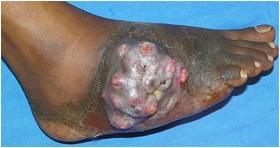The state of smart cities in MENA
11 December 2025
Published online 9 July 2013

Eumycetoma is a chronic fungal infection usually striking the tissue of the feet, leading to swelling and the formation of disfiguring 'grains' that may warrant amputation of the foot. It is endemic in tropical and subtropical regions and particularly prevalent in Sudan, where the fungus Madurella mycetomatis is to blame for the majority of cases.
In some areas of Sudan, such as the Gezira region, south of Khartoum, as many as 2% of the population suffer eumycetoma. Why the rest of the population does not develop disease, despite similar exposure to the fungus, is a question scientists from the Netherlands, led by Wendy van de Sande of the Erasmus Medical Centre, Rotterdam, and Ahmed Fahal of the Mycetoma Research Centre in Sudan have been seeking to answer, publishing two studies on eumycetoma 12 .
Attempts to infect animal models revealed that infection only occurs if the immune system is already skewed into an anti-inflammatory 'Th2' response, and points to the role pre-existing co-infections may play in predisposing people to eumycetoma.
By monitoring the coincidence of eumycetoma with two other endemic diseases in Sudan, the Th2-inducing schistosomiasis and the Th1-inducing toxoplasmosis, they observed a strong link between eumycetoma and schistosomiasis. The authors suggest that targeting schistosomiasis, such as eliminating its intermediate host, the bilharzia snail, could reduce the prevalence of eumycetoma.
In a separate study, the researchers sought to identify the habitat of Madurella mycetomatis. Comparing DNA barcodes from a wide selection of related fungi, they found that the Madurella species that cause eumycetoma are nested within Chaetomiaciae, a family of fungi that are generally found in animal dung or in dung-enriched soil.
Eumycetoma infections are thought to happen via thorn-pricks carrying the fungus. The finding that the probable ecological niche of the infectious agent is in animal dung suggests simple steps to avoid infection, such as wearing shoes or sandals.
"For the first time, intervention studies for eumycetoma can be planned to determine what kind of preventive measurements can be taken to reduce the number of cases," says van de Sande. "Based on the finding that Madurella mycetomatis is closely related to dung-inhabiting fungi, the true natural niche can be determined with molecular techniques."
doi:10.1038/nmiddleeast.2013.97
Stay connected: